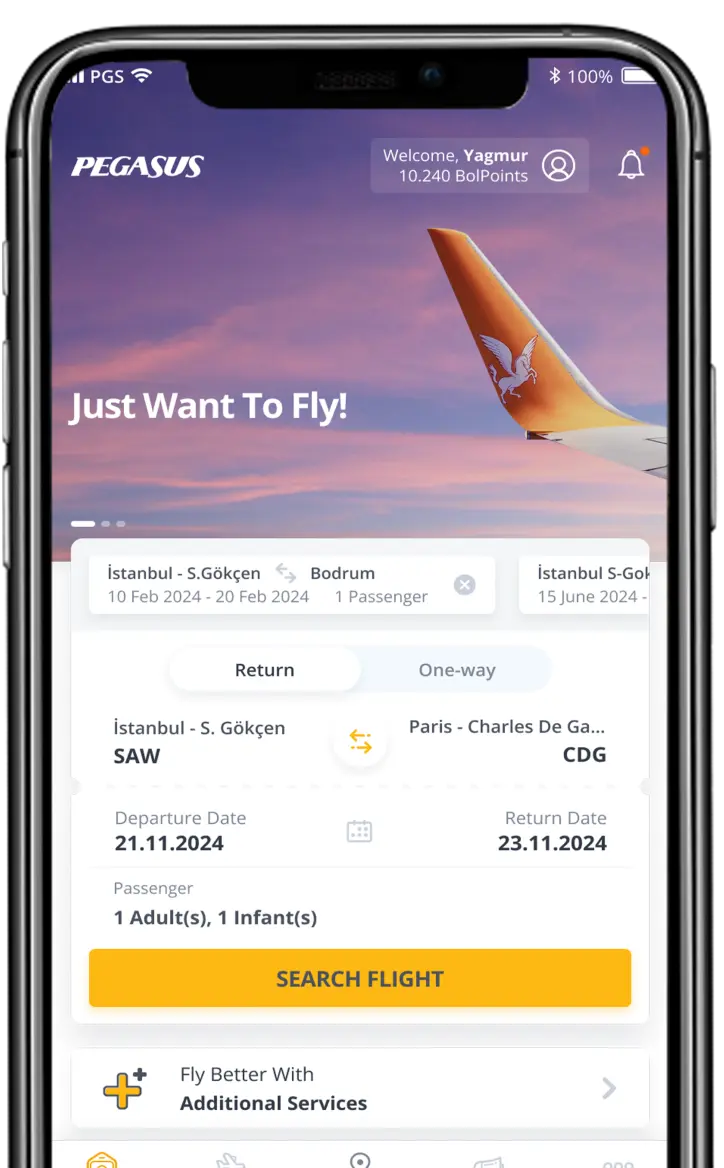
Best Flight Deals to Romania
Estimated Total Price for One Adult Passenger:
Choose Cheaper DatesPlan Your Trip

Useful Information for Your Flight

Weather Forecasts
Surrounding Countries
Did you ever wonder what it is like in the motherland of Dracula? Romania is just waiting for you to explore its cities, its wilderness and its castles. The country's capital city, Bucharest, can show you how welcoming the famously called "Paris of the East" is for its guests. Curious? Continue reading, and by the end, you will be ready to buy affordable flight tickets for your next trip!
After flying from Istanbul Sabiha Gokcen Airport, or Ankara Esenboga Airport to Bucharest Henri Coanda International Airport in Romania, it is possible to travel between Romanian cities easily. There is an advanced transportation network in Romania that covers the majority of the cities and towns.
Transportation To/From Bucharest Henri Coanda International Airport
783 Express line offers fast transportation between Bucharest city centre and Henri Coanda International Airport. You can check out Bucharest Transport Company's official website for details. This bus line is a convenient way to travel between the airport and Bucharest city centre.
Public Transport
Bucharest's main public transport options are trams, trolleybuses, and buses. Also, night lines operate during the night for an easier transportation alternative. This website can be helpful if you would like to have more details about the public transport lines in Bucharest. The public transport in the city runs from 04:30 in the morning until 10:50 in the evening. Moreover, there is a specific tourist line for sightseeing. This line enables the tourists to discover the main attractions in Bucharest. If you take the tourist line you would have the opportunity to see Free Press Square, Kretzulescu Church, Herastrau Park, The Arch of Triumph, Government Palace, National Museum of Art, Union Square, Revolution Memorial, Cismigiu Park, Opera House and more.
Bucharest also has metro lines that are M1, M2, M3, M4, and M5, with a total of 63 stations. More details about the Bucharest metro can be found on Metrorex' official website. The metro works between 5.00 a.m. and 11.30 p.m.
Is there a tourist travel card in Romania?
There is unfortunately not a special travel card for tourists in Romania. Tourists need to pay the full ticket prices to take any public transport. There is a special ticket for the airport express line, which gives a return ticket with a single ticket purchase. All passengers must buy a ticket to take any public transport. Otherwise, there is a penal fee for taking public transport without any ticket.
Transportation Between Cities in Romania
There are three main modes of transportation between cities in Romania. The domestic flights from Bucharest to Cluj-Napoca and other cities such as Timișoara, Oradea, and Suceava are the fastest options to travel between cities. Also, there are local bus lines that can help you get to almost all of the towns in Romania. Most of the local people in this country prefer taking one of these intercity bus lines since the buses generally follow the timetable. Also, it is possible to reach the smaller towns and villages in Romania by bus. IR (InterRegio) trains also travel between different regions in Romania. However, it is good to keep in mind that trains are often delayed in the country.
Where to Stay in Romania?
Romania is a rich country with accommodation opportunities for every budget. Bucharest has more than 1,500 accommodation facilities such as luxury hotels, budget hotels, hostels, and rental apartments. Bucarest city consists of six regions that each has its own municipality. Among them, the sector one, two, three, and four are the most preferred destinations to accommodate by the tourist, as these sectors have proximity to the city center and the historical places to visit. Sector one has mostly luxury hotels, whereas sector four is a more affordable area. In any case, the most popular area to stay is sector three in Bucharest.
To book your accommodation in Romania, you can take a look at the hotel reservation webpage.
Top things to do in Romania
Romania is the perfect traveling directions for the diversity of high-quality things to do and to enjoy what it has: lots of nature, beautiful architecture, mouth-watering cuisine, beautiful mountains, melodic language, and a rich, lively wealth of arts and culture.
- Transylvania and Dracula’s Castle: Peles Castle and Bran Castle, the latter is known as "Dracula's Castle," will fascinate you with their Neo-Renaissance architecture. You can easily find a combined trip to Transylvania, with the sightseeing of both castles included, with round-trip transportation and professional guides speaking your language. Other key landmarks that we would recommend to take the time to see are Sibiu, Biertan Fortified Church, Brasov, and Sighisoara.
- Bucharest Parliament Palace: Formerly known as the People's Palace, the Bucharest Parliament Palace is the second-largest building in the world and the heaviest building in the world. Inside there are several museums: The National Museum of Contemporary Art, the Museum of Communist Totalitarianism, and the Museum of the Palace, and there is also an International Conference Centre.
- The Painted Monasteries of Bucovina: This is an exciting direction for people with a historical or artistic inclination or both. Granted the status of a UNESCO World Heritage Site in 1993. The monasteries covered with vibrant murals are something that you won't regret seeing. Especially if you are there in a beautiful weather, it might even hit the top of your traveling memories list.
- Transalpina: It is a common name of the road 67C in Romania, running through the middle part of the country. It is one of the highest roads of the Carpathian Mountains, and it is its surroundings that make it a thing to consider. While taking the multiple turns, you will have all the time you need to praise the surrounding fauna and flora.
- Vulcanii Noroiosi: The Berca Mud Volcanoes are, in fact, two separate locations: The Little Mud Volcanoes and The Big Mud Volcanoes. The entrance fee is cheap, but it is only allowed on dry days (that were not preceded by raining days). This geological and botanical reservation is a miracle of nature, where you can admire the muddy eruptions, coming from the deep undergrounds of the Earth, 3000m below the surface.
For a detailed information about what to do in Romania, you may have a look at Romania Travel Guide.
We listed some useful side notes about Romania for you right below.
Things to Know Before Visiting Romania
- Romania is a safe country; there is nothing to worry about in terms of the security awaiting us;
- The local currency is a Romanian lei – as the country lies outside of the Schengen Area, though, it is recommended to exchange the currencies before arriving and using mostly cash;
- Be ready to try a lot of fantastic dishes, and keep in mind that the side dishes – such as cheese or bread – are no less delicious!
- Trains are cheap, but their quality is rather Eastern European – don't expect a TGV. Buses are a good alternative, but that is not to say that we don't recommend the trains; they are a part of the local folklore;
- As for getting around, taxis are also not a bad option – they are affordable.
- Whatever your priorities, on top of that, there has to be Transylvania. You will have to take a day trip to see it correctly, but every bit of that trip will be worth it.
Essential Numbers
Country Phone Code: +40
Airport Phone: +40 21 204 10 00
Emergency Line: 112
Turkish Consulate: +40 24 160 72 18
Turkish Embassy: +40 21 206 37 00
Airports in Romania
Pegasus uses the following airports for flights to Romania:
Bucharest Henri Coanda International Airport
Bucharest International Airport, currently the only commercial airport operating passenger flights in the capital city of Romania, is located 16 kilometers north of the city center of Bucharest. You can easily reach all the parts of the town in one of the following ways:
- Taxi – the equivalent of around EUR10-15, depending on the part of the town;
- Train – reach the Bucharest North Railway Station for as little as EUR1.5;
- Bus – get to one of a few favorably locations in Bucharest using public transport, with the associated cost of below one euro.
Car Rental in Romania
You can also rent a car with Pegasus privileges if you want to consider a more comfortable option for city transportation when you arrive in Romania for business or leisure.
FAQ
To get a cheap flight ticket to Romania, you can follow our campaigns and buy your flight ticket early.
Romania, even though it is an Eastern European country, has in itself something from the countries such as France, Spain, or Italy. The architecture is fascinating, and the local cuisine is delicious; you should especially try some of the local cheese, sarmale (cabbage rolls) and mici (grilled minced meat rolls); they are amazing, and they draw a little bit from the European Cuisine but also a bit from the Middle Eastern one.
The best time to visit Romania is around the late summer / early autumn. The winters are reckless here, and the springs are rainy – if possible, try to avoid these times of the year.
Romania uses two different time zones, depending on the time of the year: in the period between Spring and Autumn, it is EET (UTC +2), and between Autumn and Spring, it is EEST (UTC +3).
If you are an EU citizen, then you can freely travel to Romania, with a stay of up to 90 days.
For Turkish citizens, the situation is comfortable for the special passport holders – they can also stay for up to 90 days. The regular passport holders, though, are required to apply for a separate Romanian visa in advance of the trip.
The time difference is 1 hour between Spring and Autumn (summertime) and 2 hours between Autumn and Spring (wintertime).




